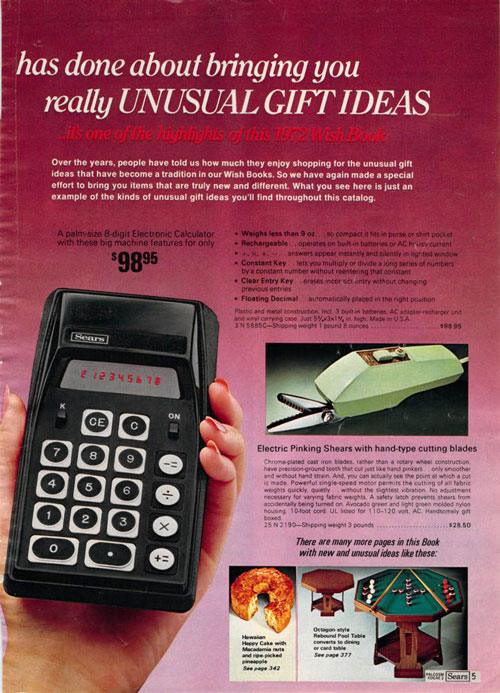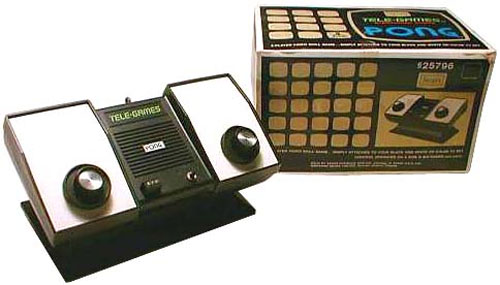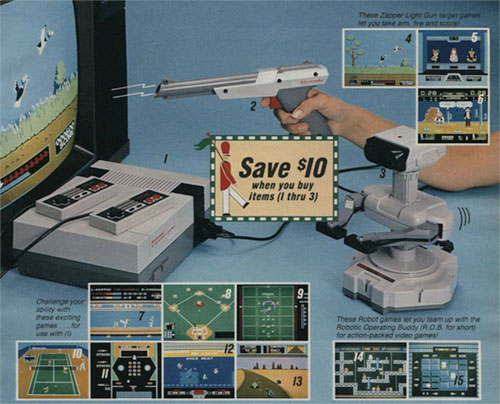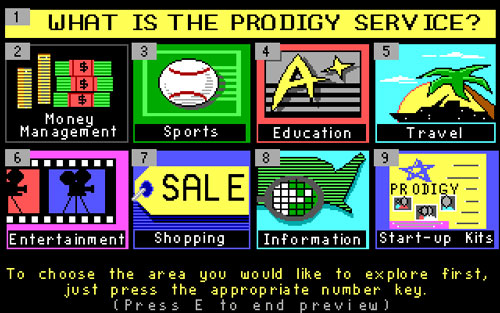Retail’s Tech Champion
Sears and Roebuck—a firm that has seen better days—helped sell the public on computers, video games, and online services. (They made great catalogs, too.)
Looking for a little help in figuring out your approach to productivity? If you’re a Mac user, be sure to give Setapp a try. The service makes available hundreds of apps that can help you get more focused, simplify complex processes, even save a little time—all for one low monthly cost. Learn more at the link.

The first home calculator sold by Sears in 1972.
The pivotal role Sears played in popularizing home electronics—especially video games
A Sears catalog, particularly a vintage one, is a real experience, as it highlights the sheer depth of the prowess of both American and global manufacturing in a very tangible way.
The company’s annual wish books, long a highlight of holiday seasons, were purely commercial endeavors. But the catalogs, which go on for hundreds of pages and are filled with all variety of toys for both kids and adults, reflected a cultural barometer of sorts. It was a yardstick of how far we had come from an innovation standpoint.
And in the 1970s, a whole lot of that innovation showed up in computer form.
(The site WishbookWeb.com is a great resource for these catalogs, and I must warn you of two things: One, it requires Flash; two, it’s a rabbit hole. If you click the link, I’ll see you next week.)
One particular standout came on page 5 of the 1972 wish book, when an 8-digit Sears handheld calculator showed up next to a set of electric pinking shears. It was not a cheap device, costing $98.95 (the modern equivalent of $589.50), but it fully deserved its very prominent place in the catalog.
Sears, of course, was the kind of company that was able to turn anything into gold for a while. The company, starting from its mail-order business, built its own stores decades before companies like Walmart entered the scene. It got away with it due to its sheer diversity as a department store. It, like its competitors at chains like Macy’s and Montgomery Ward, could sell you anything. It was particularly good at selling stuff to everyone in the family—hence why the company long had a reputation for its power tools as much as its clothing.
It was this ability to hit everyone in the family that made it particularly well suited to introduce gadgets to Middle America. Early electronics, many of which appeared in the toy aisle or were found inside the music instruments the company sold, gave way to calculators. (And automatic garage door openers—Sears was big on selling those around 1970.) Calculators gave way to video games; video games gave way to computers; computers gave way to more computers, and Sears had both the catalog listings and shelf space to give all this tech.
For its era, it had a reach that was unmatched, even by companies that specialized in this type of thing, like Radio Shack. And the computer industry was still fledgling; it hadn’t even figured out stores yet.
Of course, the true turning point, as awesome as the calculator is, comes thanks to a fateful decision involving Atari.
Here was the issue: The Magnavox Odyssey, a product that basically invented the video game market, didn’t set the world ablaze for two reasons: One, it was prohibitively expensive (it cost roughly as much as the calculator upon its 1972 release); and two, it was initially only sold in Magnavox’s own dealerships, effectively as a way to get people in the door.
And by the time Atari was interested in getting into the home video game market itself with Pong in the mid-1970s, the unproven market for home video games made things a bit of a slog.
Well, until Sears came along.
Sears had started selling the Odyssey in its catalogs, in (of all places) the sports section, despite the catalog having a dedicated electronics section. It couldn’t sell the device in its stores, because Magnavox wouldn’t let it.
In a contributed piece for the Engineering and Technology History Wiki, Allan Alcorn, the man credited with creating Pong, explained that this created an opportunity for Atari, as the buyer, Tom Quinn, felt that he was being left out of an opportunity.
“Magnavox wanted the customers to think that their video game only worked on a Magnavox set, even though it would work on any set. So they only sold it in their retail stores,” Alcorn wrote. “And Sears convinced them to let them sell it but only in the Sears catalog, not the Sears stores because they felt it would compete against Magnavox dealers. Tom knew this was a big market there, but he was frustrated.”
Atari had the right product to solve this problem, but it was brand new to consumer products and it would require some selling up the food chain. Sears, however, wanted exclusive rights—which made Atari CEO Nolan Bushnell uncomfortable, as he worried that Sears could drop them at any time.
But after a failed attempt to sell the product at a trade show, the choice was clear: If they wanted to sell this thing, they would have to go with Sears, and it would have to be exclusive.
This proved to be a good thing for a couple of reasons, beyond Sears’ natural reach; one, Atari was green at selling retail products, and two, Sears was able to help the company get past some of the headaches of selling a home video game system, particularly a Federal Communications Commission requirement that required devices that hooked up to TV sets to meet certain compliance requirements. Atari needed training wheels to pull these things off, and Sears offered them up.

The Sears Tele-Games Pong console. (Video Game History Wiki/Wikia)
So, in December of 1975, the Tele-Games Pong console came out on the market (as Sears likes to use house names for everything), and it turned out to be a massive hit. Atari soon was selling its own renditions of the device, and its follow-up, the Video Computer System (better known today as the 2600), came to life a couple years later, also with the early support of Sears.
A commercial for the Sears Video Arcade, a white-labeled Atari VCS.
Had Sears not offered Atari the help it needed at a particularly formative time in its history, our modern video game industry might have stumbled out of the gate.
It wouldn’t be the last time Sears helped electronics find their way in the world.

The NES, as it first appeared in a Sears catalog in 1986.
Five important electronic devices that Sears sold during the ’80s and ‘90s
- The Intellivision: Like Atari, Mattel allowed its device to be rebranded for Sears’ needs, with the exclusive variant for Sears called the Sears Super Video Arcade. The device was more powerful than the 2600, but had an infamous Achilles heel: A keyboard component that was made of vaporware.
- The Commodore 64: As competitors like Texas Instruments failed to make headway with their confused business models, Commodore’s Jack Tramiel showed that he was a master of mass-marketing by putting the C64 in places where the public actually shopped. This proved a turning point for computing in general. “Rather than stick to computer stores, the Commodore 64 was stocked at mass market retailers in much the same way television and game systems had broken out of their hobbyist markets,” Jake Rossen wrote on Mental Floss last month. “Seeing a Commodore 64 display at Sears helped normalize the idea of home computing.”
- Apple Macintosh: One of the first places where consumers could get their hands on both the initial Mac and the Apple Lisa was at Sears’ Business Systems Centers, an in-store computing shop that focused on business products. Unfortunately, just like many other stores that sold Apple products, Sears was throwing it out by March of 1986. That, of course, didn’t stop Sears from selling an Apple II clone, the VTech Laser 128, not long after.
- Nintendo Entertainment System: One common theme that you’ll see when looking through the Sears wish books is toy robots—lots of them—something that validates Nintendo’s early business decision to include the R.O.B. in its early NES variants. First appearing in the 1986 Sears catalog, Nintendo became a major force in gaming by 1988, and Sears dedicated much real estate to the NES in the wish book, including a full spread highlighting the games of the era. The Sega Master System, along with two Atari consoles, got nothing nowhere near this arrangement in the catalog.
- Packard Bell computers: At a time when many homes were buying computers for the first time, they were buying machines from this iconic manufacturer, whose fate we covered in 2016. Per a 1995 Fortune magazine article, Packard Bell once received half of Sears’ real estate set aside for computers.
“This is how shopping will evolve in the next 10 years. This isn’t any fly-by-night operation or some flash in a pan—this is Sears and IBM, for God’s sake.”
— An unnamed retailer offering their opinion to The Chicago Tribune on an effort called Trintex in 1987. The initiative, which would later become better known as Prodigy, was a closely watched attempt at making a graphical dial-up service with advertising deeply integrated into the mix.

A screenshot of the Prodigy service, circa 1990. (Benj Edwards/Flickr)
How Prodigy’s early success and slow failure highlights why Sears never became Amazon
If you grew up in the ’80s and early ‘90s, you may be familiar with Prodigy, an online service that helped pioneer graphical interfaces at a time when most online content was text-based.
What you might not have realized is that it was Sears’ attempt to create the information superhighway in its own image, complete with the help of IBM. The partnership, first announced in 1984 under the name Trintex, took a few forms, shed at least one partner (CBS), and cost a whole lot of money before the first consumer even got to touch it at all.
The length of time between inception and realization (it launched in 1988) meant the terminology changed in the intervening years; while “videotex” was in vogue for the teletext-style graphical approach used in 1984, the terminology faded (at least in the U.S.) after a series of failures of the technology, most notably Knight-Ridder’s Viewtron, which I mentioned here.
But it was using much of the same technology. To this day, Prodigy is the most successful use of the North American Presentation Level Protocol Syntax, or NAPLPS, graphical rendering technology, in the U.S. (For regular Tedium readers, NAPLPS was the technology on which Genesis Storytime was based.)
Part of the reason for that was that it avoided using set-top boxes that other videotex systems used and ran directly off computers, something it was able to do as a result of its relatively late entry to the market.
The effort did not exactly inspire optimism: “I’d give it a 50-50 chance,” consultant Gary H. Arlen told The New York Times in 1988. “They figured out a lot of things, but it’s still a question of whether people are sitting at home wanting this stuff and willing to pay for it.”
But in the end, Sears and IBM managed to reach further than nearly every other graphical online service of its era due to their focus on marketing and due to the service’s flat-rate costs, which stood out at a time when CompuServe charged by the hour. Linda Ellerbee, the famed journalist known to millennials as the host of Nick News, appeared in the network’s early advertising. IBM bundled the service with its PS/1 and PS/2 machines, which Sears (of course) conveniently sold.
Speaking of shopping, that was something that was deeply embedded in the concept. Users could buy stuff directly from advertisers. The model, in fact, was subsidized by the idea that people would read ads and buy stuff, and that they would use the service passively, like TV, lurking rather than interacting.
Instead, people used the service as one might assume they would: To communicate with other people, particularly through email, which was the killer application, even though it was set up for shopping-related reasons. As TechRepublic notes, this was so unanticipated that it broke their model: Prodigy users were sending too many messages, meaning it cost more to run the service than anticipated, and the unvarnished nature of the comments led to a heavy-handed approach to censorship, one that even went to the point of trying to defuse flame wars. Those advertisers needed to be protected!
In the end, Sears’ influence on Prodigy might have ended up holding it back, in part due to the clear commercial influence it fostered.
It didn’t help, either, that upstarts without such compromise baked into their model were cropping up everywhere else—including over at America Online, which was built with point-and-click interfaces in mind (unlike Prodigy), and on the open internet, which had none of Prodigy’s censorship problems.
Prodigy, over time, became more like a traditional ISP. It had to—the technology was old when it launched and positively ancient by the time the internet really took off.
“Built from systems that were state-of-the art at the dawn of the 1980s, and existing on top of a complex and proprietary network infrastructure that was always separate from the Internet, Prodigy existed in spite of itself,” tech historian Benj Edwards wrote for The Atlantic in 2014, in a piece focused on the complexity of salvaging any of Prodigy’s history that I highly recommend.
By the mid-‘90s, Sears wanted off the ride, which cost them hundreds of millions of dollars to subsidize and proved less fruitful to its goals of selling people stuff than anticipated.
In a comment to CNET in 1996, Prodigy Senior Vice President of Corporate Communications Barry Kluger described Sears’ sale of its stake of the company like someone diplomatically ending a long-term relationship.
“Sears’s decision to seek a buyer resolves a long-standing issue,” Kluger stated. “For Prodigy, it presents a wide array of new exciting options, all designed to continue to grow and enhance the asset.”
Prodigy would shut down just three years later. IBM and Sears took a sizable loss on the effort after selling it for a price less than their estimated $1 billion in investments.
Sears was an old-guard company attached to a cutting-edge technology, one that they had to sell themselves. It wasn’t like the catalogs or the stores, where all they had to do is place it in a place where consumers could buy it. Perhaps they were out of their league.
You can look at Sears’ track record in the ’70s and ’80s regarding technology and wonder what the heck happened.
In so many ways, they were out front. They helped sell and market some of the most important computing devices of the modern era, meaning they had deals with every major technology company during an era when innovation was happening, fast. They owned an online service at a time when owning an online service was actually unique and groundbreaking. And they dominated a sector—mail-order delivery—that became even more important in the internet era.
But, as all of those articles I linked at the top of the piece made clear, Sears receded into itself, embracing a stay-the-course strategy as the rest of the world was very much not staying the course. In fact, in the early ’90s, it made what in retrospect looks like a pretty sizable mistake: It got rid of the catalog.
It was part of a fire sale that saw the company lay off tens of thousands of people and drop a number of major businesses, including a spinoff of its Discover Card brand. The catalog generated more than $3 billion in sales annually, per the Chicago Tribune, but the company couldn’t figure out how to make it profitable.
“With this we are much more clearly focused on our core business,” Sears executive Arthur Martinez said, clearly not realizing what they were giving up. “We will be a leaner but more successful enterprise.”
The next year, online shopping—a market that would have helped stem those losses, a market Sears wanted for itself—arrived in a big way, without its help. As Amazon was showing the path forward for the online shopping market Sears wanted for itself, Sears was receding into its stores.
Soon, it would be purchased by a company whose fate would look just as backwards and dire, and the two companies would limp into the modern age, together.
Sears isn’t dead yet, but you know the storyline. It’s still slowly rolling out as I write this.
Let’s hope they don’t sell the memories off in the process.
:format(jpeg)/2018/08/tedium081418.gif)
/2018/08/tedium081418.gif)


/uploads/ernie_crop.jpg)